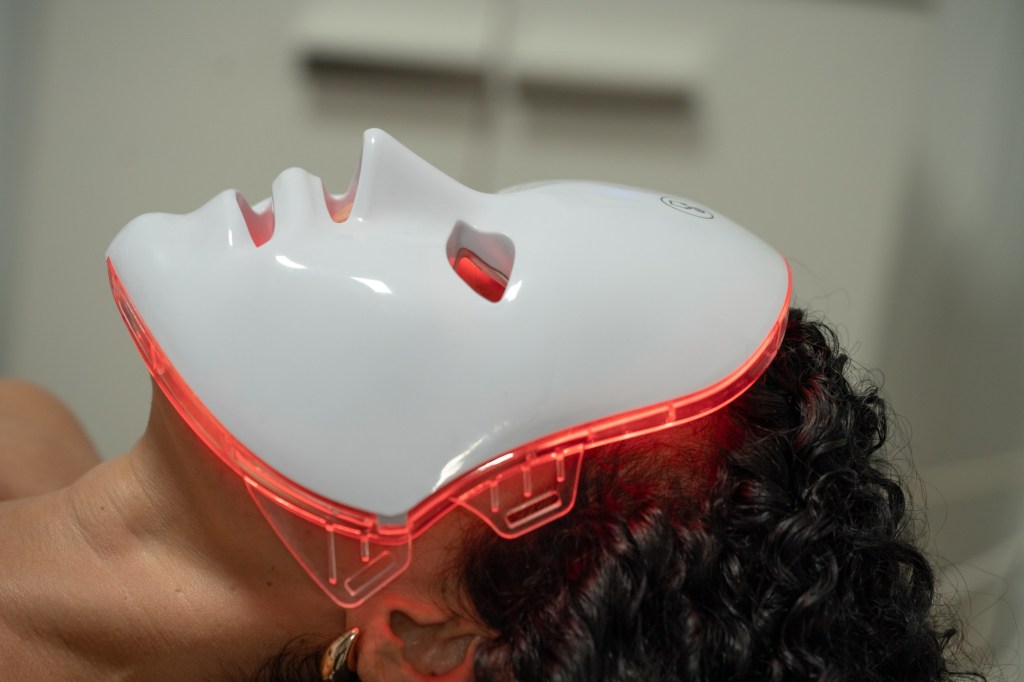
By Andrea Atkins
For The Washington Post
“Vanity” led Aubree Nichols to spend hundreds of dollars on an infrared mask three years ago in hopes that it would make the fine lines and wrinkles on her face disappear.
“I was feeling dead post-pandemic,” said Nichols, 47, of Santa Monica. The mask, which had tiny LED lights that shone on her face, “made my skin look more bouncy, more radiant,” she said. But she wasn’t expecting it to provide additional benefits — like reducing the jaw pain she’d developed or helping her fall asleep. She’s now a convert; when she recently developed shin splints, she used the mask to effectively treat her pain.
Infrared light promises to do all the things Nichols said she experienced and more. A growing body of evidence suggests that using infrared light — photobiomodulation, as scientists call it — can spur cellular changes in the body that may reduce pain, improve skin, sleep and mood, and may even be useful in treating such neurological diseases as Alzheimer’s and Parkinson’s.
But before you plunk down hundreds of dollars for an infrared light device, know that the scientific evidence is not all in yet — and that while the Food and Drug Administration has approved some red-light devices for sale, that approval is based on safety, not effectiveness.
“There has been a lot of work done in photobiomodulation, and there are a lot of interesting results,” said Mariana Figueiro, director of the Mount Sinai Light and Health Research Center in New York City. “My caveat is that a lot of work has been done with animals, not as much in clinical trials with humans. I have not seen enough studies to say I’m fully on board.”
But claims about its benefits abound on social media, in gyms and in physical therapy clinics. Here is a look at some of the claims and what the science says about each:
Pain reduction
“I’ve worked with light for more than 10 years and am already convinced that it works,” said Mohab Ibrahim, professor and director of the Chronic Pain Management Clinic at the Banner-University Medical Center at the University of Arizona. “Studies show that light modulates immune cells such that they release less inflammatory mediators. Inflammatory mediators increase inflammation and pain. Light also increases the release of anti-inflammatory cytokines, and it modulates the endogenous opioid system. I don’t want to say it’s like taking morphine, but it is the body’s pain modulating system.”
But photobiomodulation is still relatively new and may not be ready for prime time. “My issue is when a scientific group comes up with findings, and all of a sudden there are copy cats that put a product on the market without proof of concept,” he said. “I’m looking for proof of concept. It doesn’t tell you how well it will work or for who. It needs more attention.”
Could the treatment someday replace potentially addictive prescription painkillers?
“If someone needs 5 milligrams of oxycodone four times a day, would I be able to reduce it to two times a day [with light therapy]? That’s utopia. Light does not have an instantaneous effect – it’s inducing changes at the molecular level,” he said. “Physicians will have to tailor this to an individual.”
As for at-home devices, Ibrahim tells his patients: “Make sure you can return it. Then give it three to four weeks. If you don’t see benefit by then, I doubt it will be beneficial.”

Skin
Light “turns certain biological signals on, which has downstream effects for the skin,” said Amit Om, a dermatologist in Charlotte. “It stimulates collagen production, improving skin texture, reducing fine lines and signs of aging. It can work on acne scars and reduces inflammation and promotes healing. It also improves skin elasticity.”
Studies have proved infrared light safe, but, Om added, “there are a lot of questions about how to maximize the usage of it. We’re not there yet.” He said it’s still unclear how long and how often to use infrared light and what conditions it can treat.
“There is a huge push for red light on social media. If you ask 10 different dermatologists, you might get 10 different views,” Om said. “I don’t think it’s a magic wand. It might be helpful, but not as helpful as some other things we have for the same conditions – retinoids, fraxel lasers.”
“I tell patients that if they want to try it, they can use it three times a week for 10 minutes each time. Don’t use it seven days a week,” Om added. “A lot of these results will be subjective – someone may feel that a particular dark spot doesn’t show as much. To be sure, they should take a photo today and then take another one in the same lighting and angle in two months.”
Sleep
A recent study on humans in the journal Neural Regeneration Research suggests that photobiomodulation may improve sleep. But Figueiro, an expert in circadian rhythms, is not so sure, noting that the studies so far have been small and mostly in animals. Still, an at-home device might induce sleep. “The little bit of heat may feel good and the placebo effect is something to be considered,” she said.
Some studies have suggested that infrared light can clear the glymphatic system, which removes waste from the central nervous system. “If it can clear the glymphatic system, that would be something important in terms of improving the quality of your sleep — not making you fall asleep — but it might help with clearing the brain,” Figueiro said.
Mood disorders
Patients with major depressive disorder or other mood disorders often find their way to the Depression Clinical and Research Program at Massachusetts General Hospital, where Paolo Cassano, a professor of psychiatry at Harvard Medical School, is director.
“More often than not, when they come to us, they have tried many interventions already — antidepressants, SSRIs, cognitive behavioral therapy, interpersonal therapy, even sometimes electroconvulsive therapy,” Cassano said. “We use lasers on their forehead — using a lower dose and progressing to find a dose that is both effective and still very tolerable. Treatments are quick — could be five to 10 minutes.”
The infrared light increases cerebral blood flow, increasing oxygenation and ATP levels (which are molecules produced by the mitochondria in cells), Cassano said. He added that in animal studies, serotonin (often called the feel-good hormone) increases while cortisol (also known as the stress hormone) decreases. It is also free from side effects, he said.
“Increasing blood flow, oxygenation and ATP molecules can improve depression,” said Cassano, who has conducted studies of the effect. “There are other hypotheses. Light also accelerates brain oscillations and leads to more neuronal firing so a patient could be lifted out of a depressive state.”
But Cassano is skeptical of at-home devices. “It is possible that if you have an at-home device, it might have a therapeutic effect,” he said. “Do we have proof of that? Not really. Quite frankly, it’s not clear how over-the-counter LED, low-power devices compare to the in-office power devices. We’re hoping to study this question.”
Photobiomodulation will not replace SSRIs or other medications, “but device-based intervention will be an additional branch,” he predicted.






